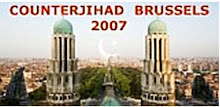
I’m fed up of listening to the US Cato Institute mantra, “pull Government out of Government,” and “free market—free market,” repeated by the US and UK Conservatives and other so-called Libertarian capitalists throughout the Western financial circles. It’s an invitation to anarchism where hooligan Bankers thrive, discarding the shackles of normal regulatory controls and then risking other people’s money in a Cavalier manner. Laissez-faire economics is economics Viking style: bash, grab and run—eminently suitable for the NINJA Mortgage Bankers who then fob off their toxic waste onto others less prudent and financially aware, backed by useless unregulated Credit Rating Agencies.
In a civilised society, we have police to prevent hooligans on the streets from mugging the innocents, and in financial circles, we need the same sort of police to regulate the hoodlum Banker from mugging the innocents with worthless toxic papers. The only policeman the Bankers will listen to is Government regulators. That is why we elect a Government—to put order into society—to regulate and prevent anarchy. Minimising Government suits those with money—not society as a whole.
The “free market” mantra is espoused by those who really want to loosen all Government controls and be allowed to do what they can get away with on the financial stage. Edward H. Crane hid behind Cato the Younger’s venerable name in imitation of John Trenchard and Thomas Gordon, who had good reason to hide their identity from the Hanging Judges of the day—but Edward H. Crane hid for PR reasons, judging that Cato’s name would give his modern Viking ambitions, respectability. This so called “libertarian think tank” wishes to limit government [regulation], promote individual liberty [to buy more guns and set up survivalist camps], encourage [Viking style] free markets, and sponsor peace [a piece of the action]. The devious Institute advocates diminished government intervention in domestic, social, and economic policies and decreased military and political intervention worldwide.
Before WWII, the latter was called “isolationism,” and made this Ostrich stance highly unpalatable at home and to the rest of Europe. It created Pearl Harbour because the Japanese didn’t think the US would react. Head-in-the-sand means you get your arse kicked without knowing who’s doing the kicking. With the current TEN super aircraft carriers, the US is a worldwide power, and withdrawing into isolation, as the Cato Institute advocates, means others will fill the void at the US’s expense. THE CLOCK CANNOT BE TURNED BACK—or don’t they know that? You can’t go back to 50BC or 1755. Grow up and live with the present day complexities! Stop trying to look for “idealised” solutions.
Libertarian dogma is just as bad as Liberal dogma. Both suck! Both are bipolar rigid forms of thinking and counter survivalist. Survival of the fittest, Darwinian style, means you get stuck in and battle it out—not become an isolationist idealist. Cato Institute “expert scholars” blame “Government” again-and-again in differing tedious language promising that if only Governments would stop being Governments, all would be well in the “libertarian free market.” Don’t they understand that each problem has its individual solution and in a complex world, the solutions are complex? So live with it! Stop looking for nonsense ideals and the easy ways out.
That Penn & Teller are also Fellows of the Cato Institute, may give an indicator as to where its libertarian policies originate—in illusionism? Another “honoured” follower is Thomas Szasz, whose views on special treatments follow from classical “liberal roots” based on the principles that each person has the “right to bodily and mental self-ownership.” Szasz believes that suicide, the practice of medicine, use and sale of drugs and sexual relations should be private, contractual, and outside of state jurisdiction. [Doctor Kevorkian for President? Mass murdering GPs? Quacks? Heroine? Cocaine? Paedophilia? Rape? All out of state control? Is he totally irresponsible?] Szasz also thought schizophrenics were just normal people and should be accepted as such. He claimed that “mental illness was a myth.” 99.5% of Psychiatrists disagree.
Worse than the above and most damning of all, for me, is the Institutes constant harping back to 1787, as if they were incapable of moving on, or living in the present. In David Boaz’s Libertarianism: a primer (1977), Boaz ends his “primer” with the paragraph heading: “Toward a Framework for Utopia,” with the following crass sentence: “I'm pretty sure we will be freer 100 years from now, and I'm confident that our descendants 1000 years from now will live in a freer world. The third millennium will be the millennium of the free individual.” I’ve rarely come across such awful drivel as claiming to predict what we will be like in a 1000 years, and another Utopia at that. Look back a 1000 years and compare it to now—would anyone have predicted in 1000 AD what we have now? Predictions of such a time scale are sheer nonsense—which condemns the “primer” as no better than that French apothecary, Nostradamus's Les Propheties.
Furthermore, the type of people the Cato Institute attracts is people who want to do as they please without any interference from societal norms. Anarchism by another name while hiding behind Cato the Younger (95–46 B.C.), who may have championed liberty and republican principles, but that was TWO THOUSAND YEARS AGO, when slavery was the norm. Maybe Edward H. Crane hopes to be installed as a new magister populi if he can convince the US to reinstall the old Roman Republican ethos? I suggest Crane has more in common with Julius Caesar than Cato the Younger! What about renaming his baby, the “Caesar Institute?”


















